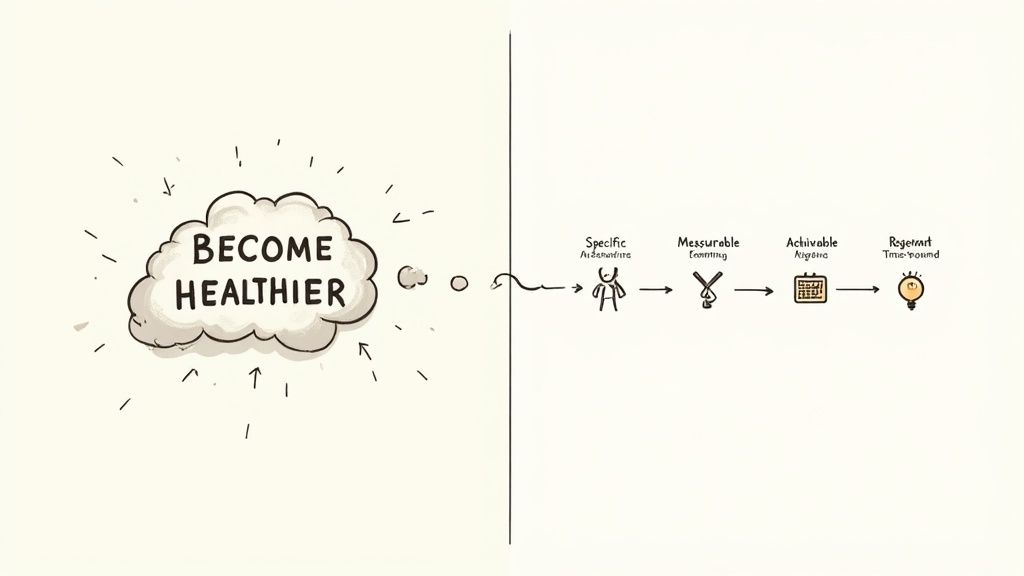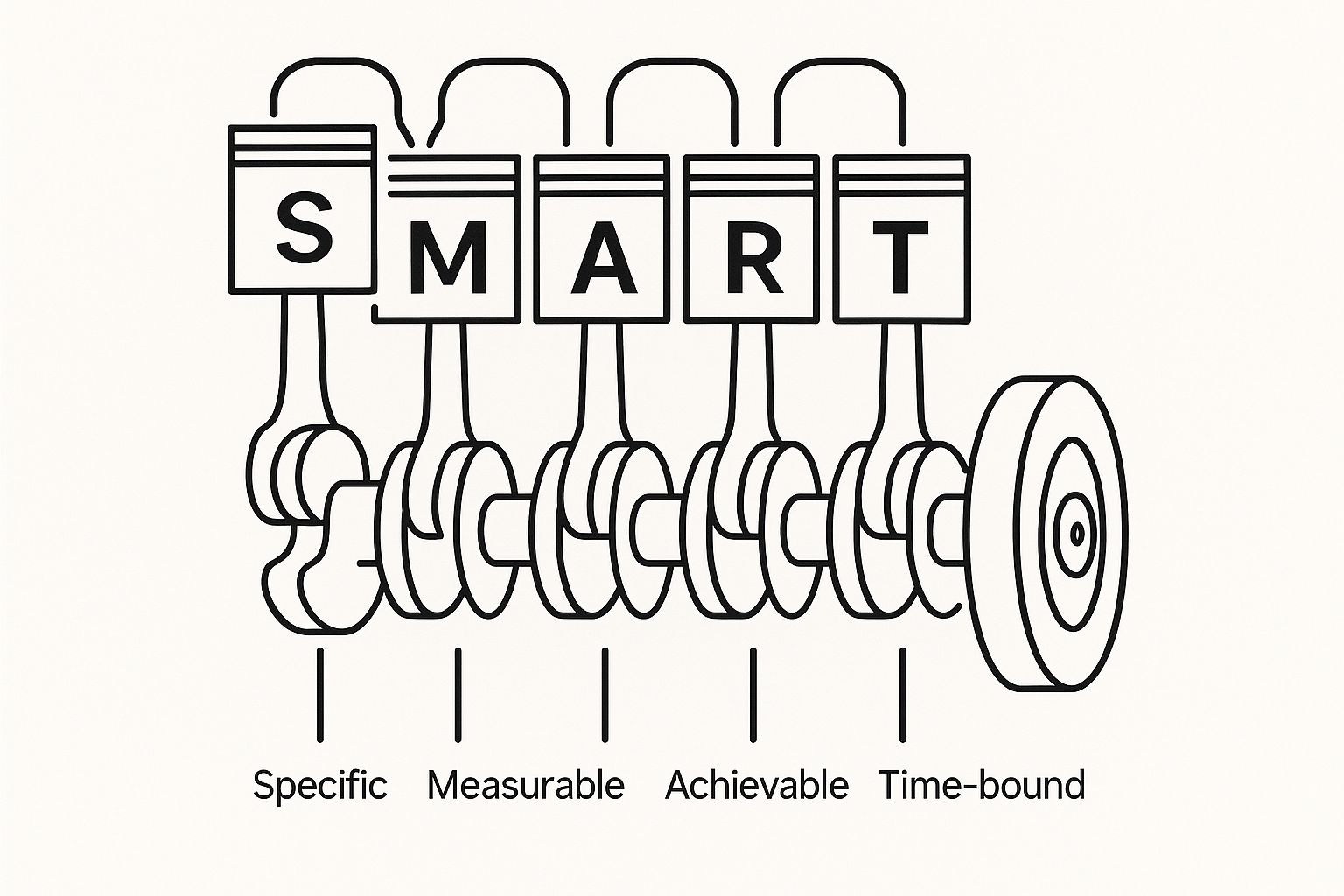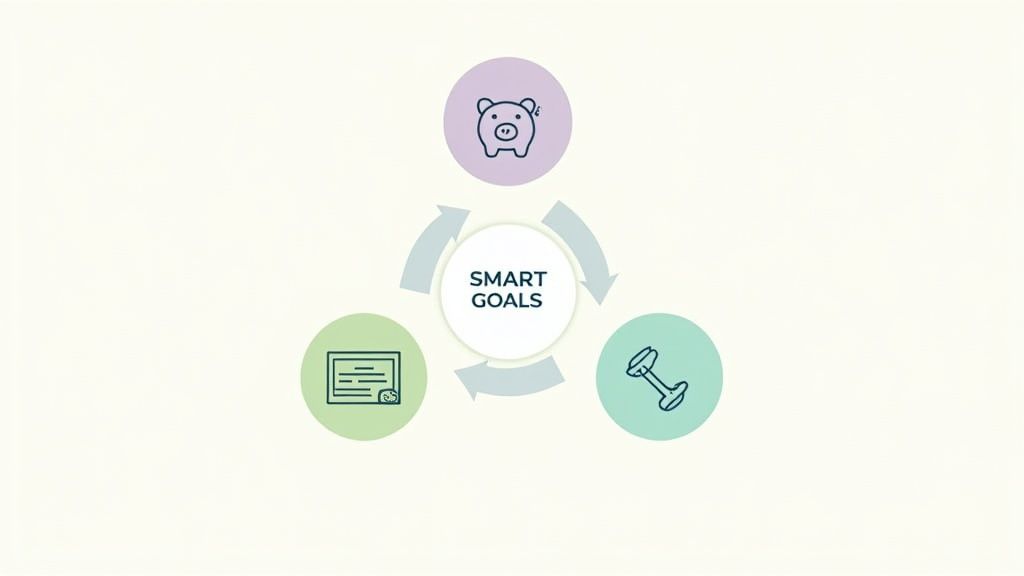What Are Smart Goals? A Simple Guide to Effective Goal Setting

We’ve all done it. We set a goal like "get in shape" or "be more productive." These are great starting points, but they're fuzzy. They lack direction. It’s like wanting to drive to a new city without a map—you might wander around for a bit, but you’ll probably get lost and give up.
This is exactly where the SMART goal framework comes in. It's a simple, powerful system for turning those vague ambitions into a concrete roadmap for success.
From Vague Ideas to Actionable Plans

The real magic of SMART goals is in their structure. They force you to dig deeper than just a wish. You have to define exactly what you want to do, why you're doing it, and how you’ll know when you’ve succeeded. This structured thinking strips away the guesswork and lays out a clear path from day one.
Think of it as a checklist for building a better goal. Each letter in the SMART acronym acts as a filter, ensuring your objective has all the ingredients it needs to succeed.
Let's quickly break down what each part of the framework means.
The SMART Framework At a Glance
Here’s a simple table that sums up each component of a well-crafted SMART goal. It's a handy reference for making sure your own goals tick all the right boxes.
Specific
Clearly answers the "W" questions: Who, What, Where, When, and Why.
Measurable
Defines how you will track progress and know when you’ve hit the target.
Achievable
Confirms the goal is realistic given your current resources and constraints.
Relevant
Ensures the objective aligns with your bigger-picture vision and values.
Time-bound
Sets a clear deadline to create urgency and keep you focused.
By running your goals through these five criteria, you transform a hopeful wish into a concrete mission. This clarity doesn't just boost your motivation; it dramatically increases your odds of actually getting it done.
This simple shift from "I want to..." to a fully-formed SMART goal is often the biggest difference between staying stuck and making real progress.
Turning these ideas into a visible plan can be a huge help. Using a free timeline template generator is a great way to map out the steps and deadlines. For a more integrated approach, a knowledge management tool like Obsibrain lets you build a dashboard for your goal, connecting your action plan directly to your daily notes and tasks, ensuring nothing gets lost.
Mastering Each Element of a SMART Goal
To really nail down what SMART goals are all about, you have to break down the acronym. Think of it like a high-performance engine; each letter is a critical component working together to drive you forward. Vague goals are where good intentions go to die, but this framework provides the structure you need for real momentum.
The infographic below shows how each piece—Specific, Measurable, Achievable, Relevant, and Time-bound—acts as a cylinder, powering the whole goal-setting engine.

This visual makes it clear that no single element is optional. Every part is essential for the system to fire on all cylinders and actually produce results.
Specific: The Who, What, and Why
A Specific goal leaves absolutely no room for interpretation. It’s the difference between saying "I want more customers" and "I will acquire 10 new B2B clients in the manufacturing sector." That second one gives you a clear target.
To get this level of clarity, just answer the classic "W" questions:
What exactly do I want to accomplish?
Why is this goal so important to me or the business?
Who needs to be involved to make it happen?
Where will this take place?
Which resources or constraints are part of the picture?
Nailing this down eliminates confusion right from the start and gives you a precise target to aim for. A great use case in Obsibrain is creating a project note for your goal and using a template to prompt you to answer each of these "W" questions, ensuring you don't miss any details.
Measurable: Tracking Your Progress
If you can't measure it, you can't manage it. A Measurable goal has metrics baked right in so you can track your progress and know exactly when you've hit the mark. It’s all about answering, "How will I know when it's done?"
For instance, "Improve website performance" is fuzzy. A measurable version is, "Increase website traffic by 15% and reduce page load time to under 2 seconds." Tracking these numbers gives you undeniable proof of progress. With a tool like Obsibrain, you can keep an eye on your progress using its built-in habits and goals tracking features, creating a clear scoreboard for your ambitions.
Organizations that adopt SMART goals are approximately 12% more effective in achieving their objectives compared to those with unstructured goals. Furthermore, clear goals can lead to a 37% increase in employee engagement. You can discover more about these goal-setting effectiveness statistics and their industry impact to see the full picture.
Achievable: Realistic, Yet Challenging
An Achievable goal is one you can realistically pull off. It should stretch your abilities but not be so out there that it's basically impossible. Take a hard look at your current resources, skills, and time.
Setting a goal to write an entire novel in one week probably isn't achievable. But aiming to write one solid chapter per week? That’s a challenging yet realistic target.
Relevant: Aligning With Your Vision
Your goal absolutely must be Relevant to your bigger vision or long-term objectives. It needs to pass the "Does this seem worthwhile?" test. If your big-picture objective is to build a stronger online brand, a goal to learn a new coding language might not be as relevant as a goal to grow your LinkedIn network.
Time-Bound: Creating a Deadline
Finally, every goal needs a deadline. A Time-bound goal creates a healthy sense of urgency and stops tasks from being pushed to the back burner forever. To really get a handle on this, it's worth exploring strategies for effective Time Management Smart Goals, as they offer a great framework for staying on schedule.
Seeing SMART Goals in the Real World
Theory is one thing, but seeing the framework in action is where its power really clicks. It’s one thing to know what SMART goals are, but it’s another to watch vague ideas transform into actionable plans. Let's look at a few clear "before" and "after" scenarios to see how it works.

Think of these examples as blueprints. You can easily adapt them for your own objectives, turning foggy intentions into focused missions.
Example 1: Personal Finance
So many of us start with a general financial wish. The problem? It often leads to inconsistent effort and very little progress. A SMART goal provides the structure you need to actually make headway.
Before (Vague Goal): "I want to save more money."
After (SMART Goal): "I will save $5,000 for an emergency fund within 10 months by setting up an automatic transfer of $500 from my checking to my savings account on the first of every month."
See the difference? The "after" version is specific ($5,000), measurable ($500/month), achievable (based on a realistic budget), relevant (builds financial security), and time-bound (10 months). It replaces wishful thinking with a concrete, automated plan.
Example 2: Career Growth
Professional development ambitions can easily stall without a clear target. Applying the SMART framework creates a direct path to acquiring new skills and moving your career forward.
Before (Vague Goal): "I need to improve my skills."
After (SMART Goal): "I will earn a professional project management certification by December to qualify for a senior role. I will dedicate five hours per week to studying and complete one practice exam each month to track my progress."
The difference is the roadmap. The SMART version outlines not just the destination (certification by December) but the exact steps needed to get there. Suddenly, the goal feels far less intimidating and much more manageable.
Example 3: Health and Fitness
Health-related goals are notorious for being vague. "Get fit" could mean almost anything, which is exactly why it so often fails. A structured approach gives you something concrete to work toward.
Before (Vague Goal): "I want to get in shape."
After (SMART Goal): "I will improve my cardiovascular health by running a 5K race in under 30 minutes within 12 weeks. I will follow a beginner's training plan, running three times per week and strength training twice per week."
In every case, the SMART framework provides clarity and a direct course of action. For complex goals like these, a tool like Obsibrain becomes invaluable. You can create a dedicated project note for each goal, breaking it down into specific tasks, setting deadlines, and tracking your progress all in one place. This turns your goal from a static idea into a dynamic, manageable project.
Why This Framework Actually Works
Let's be honest, we've all set vague goals like "be more productive" or "get in shape." The problem? Our brains don't know what to do with them. A goal without a clear finish line is just a recipe for procrastination, leaving you feeling overwhelmed before you even start.
The SMART framework cuts through that fog by giving your brain something tangible to latch onto. When a goal is specific and measurable, it stops being a fuzzy wish and becomes a clear target. You can actually visualize the endpoint, which makes it much easier to figure out the steps to get there.
Turning Ambition into Action
This structured approach does something else powerful: it creates a feedback loop that keeps you motivated. Every time you hit a measurable milestone—like landing a weekly sales target or finishing a chapter of your book—your brain releases a little bit of dopamine. That's the chemical that makes you feel good, and it creates a positive cycle that keeps you hooked on making progress.
Deadlines are the secret weapon against "I'll do it later." Without a time-bound element, a goal can drag on forever. Adding a deadline forces you to get serious, prioritize what matters, and make sure every bit of effort is pushing you toward a real outcome.
The real magic of the SMART framework is that it turns a passive wish into an active pursuit. It gives you the structure you need to build momentum and, more importantly, keep it going.
And this isn't just theory; it's proven to get results. One implementation study in rehabilitation services found that using SMART principles significantly improved how teams and clients developed a common focus. It also boosted action planning and feedback across multiple sites. You can read the full study on goal-setting protocols to dig into the findings yourself.
For really complex goals with lots of moving parts, a tool like Obsibrain is perfect for breaking down each SMART component into trackable tasks, so you never lose sight of the finish line.
Of course. Here is the rewritten section, crafted to sound like an experienced human expert.
Common Goal-Setting Mistakes to Avoid
Knowing the SMART framework is one thing, but actually dodging the common traps that derail your goals is a whole other ballgame. It’s easy to get excited about a new system, but even the best-laid plans can fall apart if you stumble into a few classic goal-setting mistakes. These are the pitfalls that can turn a clear roadmap into a frustrating dead end.
One of the most common errors? Setting goals that are wildly unrealistic. Ambition is great, but aiming to double your revenue in a month without the resources to back it up is just setting yourself up for disappointment. This isn’t about limiting your potential; it’s about building real momentum with achievable wins.
On the flip side, goals that aren't ambitious enough won't get you out of bed in the morning. If a goal doesn't challenge you, it’s unlikely to hold your attention or push you to grow. The sweet spot is a target that stretches you but still feels within reach.
Failing to Track and Adjust
Another critical misstep is the "set it and forget it" approach. Goals aren't static—they’re living objectives that need regular check-ins. Without consistently tracking your progress, you have no way of knowing if your strategy is working or if you need to pivot.
This is a surprisingly common problem in professional settings. Despite the obvious benefits of structured goals, many organizations just don't follow through. A 2020 survey found that only about 51% of companies even try to develop aligned goals, and of those, a tiny 6% actually revisit them regularly. You can discover more insights on goal-setting statistics to see how widespread this issue is.
A goal without a review process is just a wish. Regularly checking in allows you to make smart adjustments, celebrate small victories, and stay motivated for the long haul.
Creating Irrelevant or Vague Goals
Finally, two other mistakes can completely undermine your efforts: setting goals that are irrelevant or just plain vague. A goal might be perfectly structured, but if it doesn't connect with your bigger vision (the 'R' in SMART), you'll struggle to find the motivation to see it through.
And if you don't define exactly what success looks like, how will you know when you've achieved it? Failing to nail down clear metrics is a recipe for ambiguity. For complex objectives with a lot of moving parts, a tool like Obsibrain can be a lifesaver. It helps you break down each goal into trackable tasks and metrics, making sure you have a clear definition of success right from the start.
Putting SMART Goals Into Action with Obsibrain
Knowing the SMART framework is one thing; actually putting it to work is another. A great framework is only as good as the tool you use to bring it to life, and that's where the real magic happens. This is where Obsibrain steps in, acting as your command center to turn the SMART method from a cool idea into a living, breathing plan.
Instead of letting your goals get scattered across random apps, sticky notes, or forgotten notebooks, Obsibrain gives you one central place to manage everything. You can create a master note for each big goal and then break it down piece by piece.
Building Your Goal Dashboard
Let's say your goal is to "Earn a Project Management Certification." Instead of just writing that on a to-do list, you can build a dedicated project dashboard for it right inside Obsibrain. This turns a static wish into an interactive plan you can manage every single day.
Here's how you could structure it:
Specific: Create a header that clearly defines the exact certification you're aiming for and why you're doing it.
Measurable: Use checklists to track your weekly study hours or the scores from your practice exams.
Achievable: Break down huge topics like "Study Chapter 4" into smaller, less intimidating tasks with their own due dates.
Relevant: Link this project back to a main "Career Development" note. This simple link keeps your ultimate "why" right in front of you.
Time-bound: Set the hard deadline for your exam date and create smaller milestone dates for finishing each study module along the way.
This approach transforms a simple goal into a dynamic project. To see more on how to set this up, you can check out our guide on SMART projects within Obsibrain.
The real power here is in the connection. Your daily tasks, your weekly progress reviews, and your long-term ambitions all live together in one interconnected system. Nothing gets lost, and nothing falls through the cracks.
With a central dashboard, you get a bird's-eye view of your progress, see what's coming up next, and make adjustments when life inevitably happens. It moves your goals from being a passive list of things you should do to an active, organized system you can confidently manage.
Last updated
Was this helpful?